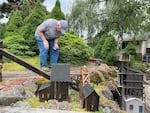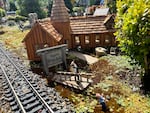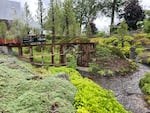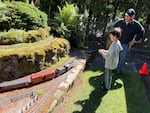“A steam train!” a young boy exclaimed, shaking his hands with wild enthusiasm. “Look at that one!”
He sat cross-legged on the ground in the backyard of Alan and Nola Olsen, literally shaking with excitement as a tiny steam train crossed over a handmade miniature covered bridge, turned the bend of a trestle above actual rushing water, past a perfect replica of a Mount Hood historic church, and chugged past him on a miniature track before disappearing into a tunnel.
Trains — the massive movers of industry around the globe — are a long-standing curiosity of children. For some folks, that passion only grows deeper with age.
In Portland, a dedicated group of hobbyists take their love of trains into their backyards. Or, you could say, they allow their passion for trains to take over their backyards.
For them, the world of trains winds through expansive landscapes — complete with tiny towns with Wild West saloons and sawmills, and even forests of manicured trees and rushing rivers of real water.
These backyard train layouts, known as “garden railroads,” have become more than just a hobby; they are living landscapes that weave together passion, precision and nostalgia and reflect Oregon’s heritage.
For the members of the Rose City Garden Railway Society, the highlight of the year is showing off their backyard masterpieces to the public with an annual tour, which is scheduled for June 14 this year.
Full circle: returning to a childhood joy
For many members of the Rose City Garden Railway Society, like Gary Lee, the love of trains dates back to childhood.
“I can remember as a little child in the early ‘50s, big black trains going by that would make the glass shake,” Gary recalled. “I would run to the window to see that happen.”
Club member Tom Gaps’ love of trains was nurtured by his father. After completing his boyhood job delivering newspapers, Gaps and his dad would drive out to the Columbia Gorge.
“It was always a race to get all the papers delivered, so we could catch the last steam engine running out of Portland,” Gaps remembered fondly.
However, in adulthood, life’s responsibilities — careers, marriage, children — often pushed those interests aside.
But for many in the Rose City Garden Railway Society, retirement provided an opportunity to return to their childhood fascination with trains.
“When you retire, it’s like, ‘OK, I’m through with worrying,’” Gaps said. “Now I can enjoy life. What did I enjoy as a kid? Playing with trains! So, I’m going to play with trains again — but in a different way.”

Tom Gaps runs his backyard garden train, the "Lone Pine & Western Railroad," in June 2024.
Ian McCluskey / OPB
Backyards with personal stories
The backyard railroads of the club’s members are elaborate, personalized works of art, each layout telling its own unique story.
For Alan and Nola Olson, the “Crooked River Railroad” is a storybook of their lives: a miniature bank building with a sign above the door is a nod to Alan’s grandfather, who worked as a banker; a photographer snapping a picture of loggers posing beside a stump is a reference to Nola’s grandfather; and a tiny tree with a heart and their initials carved into it is a tribute to their marriage.
“I always try to put touches of humanity because trains are trains, but I like human stories,” Nola Olson said.
Their railroad layout is also a tribute to Oregon’s history, with elements that reflect the state’s heritage, such as grist mills, sawmills, and logging camps.
One of the most meaningful aspects of the Olsons’ railroad is the scale model of the church that Alan attended as a child on Mount Hood. The “Chapel of the Hills” church was originally built in the 1930s by renowned cabin craftsman Henry Steiner. It burned down in the 1980s.
Club member Gary Lee, a certified Master Model Railroader, helped recreate the log church with exacting details of the original, allowing Alan Olson to honor his past in miniature.
“It means a lot,” Alan Olson said. “It’s part of my childhood, part of my upbringing, part of who I am.”

Alan Olson displays a scale replica of a historic church that once stood on Mount Hood, built in the 1930s by Oregon's famous cabin craftsman, Henry Steiner.
Ian McCluskey / OPB
The rivet counters
For some members, creating a model railroad isn’t just about creativity — it’s about authenticity and accuracy.
These enthusiasts are affectionately known as “rivet counters.”
“You can look at one of their locomotives and count the number of rivets,” Gaps explained. “They’ll make sure it’s exactly the same as the real thing.”
Gary Lee is one such “rivet counter,” and his attention to detail is evident in his work. Also a certified master of model railroads, Lee has handcrafted the cedar ties for his railroad tracks, carefully driving each tiny spike by hand.
“Four spikes on each tie,” Lee said as he leaned over and pushed the end of a nail punch with his chin for extra force. “I estimate I’ve driven at least a quarter-million of these tiny spikes.”

Gary Lee's "Baker & Grande Ronde Railroad," photographed in June 2024, is painstakingly accurate in its details, down to hand-driven railroad tie spikes and a scale locomotive actually powered by steam.
Ian McCluskey / OPB
Creating community
While garden railroading is often a solitary endeavor, much of the joy in the hobby comes from the sense of community.
For Alexis Barbaris, the bonds formed with fellow club members have become especially meaningful after the death of her husband, Frank.
Together since high school, she and Frank built the ”Pine Valley & Western Railroad” in their backyard. With his death, one of his projects was left incomplete — a scale replica of a building that houses locomotives, known as a roundhouse, and turntable that spins locomotives from the roundhouse back to the tracks — a historic center point of the old railroad yards.
The Rose City Railway Society stepped in to help assemble the kit, wire it up, and even added a small memorial plaque to honor Frank.
“All these guys from the club showed up, and they built it. I can’t thank them enough,” Barbaris said, holding back her tears. “It was his dream.”

During the Rose City Garden Railway Society annual summer tour, kids are often handed the controls and allowed to run the trains, as seen in this photograph of a 9-year-old who attended the club tour in June 2024.
Ian McCluskey / OPB
Seeding the future of garden railroading
While the club’s members are deeply connected to the past, they are also focused on ensuring the future of the hobby. Many of the members are in their retirement years, and there’s a concern that as they age, the interest in garden railroading may fade.
“We’re all baby boomers, so we’re going to age out,” Lee said.
Their annual tour was launched to generate interest among younger generations. The club intentionally keeps the price affordable, with tickets at $10 per family, to encourage as many people as possible to visit their railroads.
On the day of the tour, families can visit any of the backyard railroads on the tour. Not long after opening, many of the backyards fill with crowds of curious onlookers.
During this event, kids are often handed the controllers so they can run the trains. For a moment, they are the engineers of their own miniature world.
For folks who are curious about getting started, member Tom Gaps hosts an introductory workshop.
People do not need model trains, or even backyards, to join the club, Gaps explains. The group has a program to resell used tracks at a discount.
“None of the layouts on the tour started out as you see them now,” Alan Olson said. “It happens piece by piece, sometimes just a circle of track and a single train. And then you add a building, and then you just want to keep going.”
A joke the members often hear: “Aren’t you a little old to still be playing with trains?”
Club member Bill Derville replies with a grin: “To someone who doesn’t think this is worthwhile, I’d say, ‘Grow up! Or grow down!’
“Because this is fun!”
